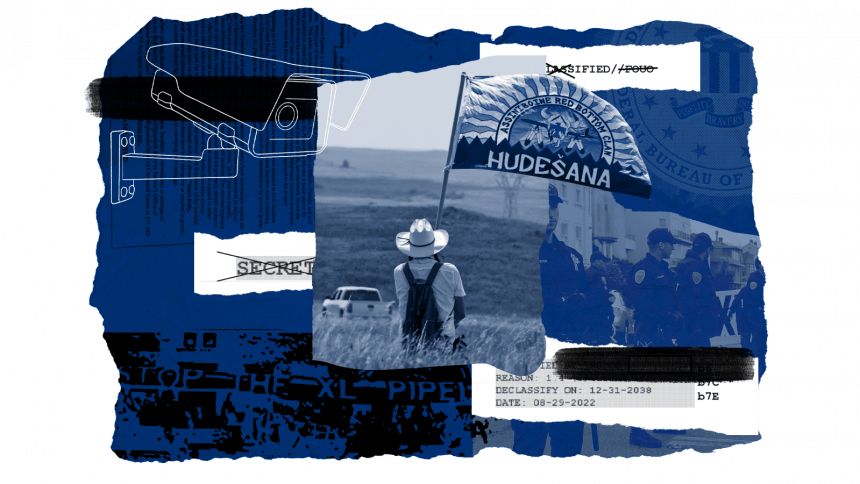Keystone XL pipeline protests
This article was produced in partnership with Type Investigations, where Adam Federman is a reporting fellow.
On the morning of March 5, 2012, Debra White Plume received an urgent phone call. A convoy of large trucks transporting pipeline servicing equipment was attempting to cross the Pine Ridge Reservation near the town of Wanblee, South Dakota. White Plume, a prominent Lakota activist, immediately dropped what she was doing and headed to the site, where, within a few hours, a group of about 75 people from the Pine Ridge Reservation gathered. More than a dozen cars formed a blockade along one of the roads that runs through the reservation.
Plume and other activists were outspoken critics of the proposed Keystone XL pipeline, part of a larger network carrying oil from the tar sands of northern Alberta, Canada, to refineries on the U.S. Gulf Coast. Many Indigenous nations in South Dakota, whose land the convoy was attempting to pass through on its way to the Canadian tar sands, fiercely objected to the project. “We have resolutions opposing the whole entity of the tar sands oil mine and the Keystone XL pipeline,” White Plume declared after arriving at the site where the trucks had been stopped. “They need to turn around and go back. … They are not coming through here.”
But the trucks were so big and unwieldy that the drivers said it would be dangerous, if not impossible, to turn them around. The standoff in Wanblee was a relatively small protest compared to subsequent actions against the Keystone XL pipeline, which drew tens of thousands into the streets of Washington, D.C., and garnered national attention. Police arrested five activists, including White Plume (who died in 2020) and her husband, Alex White Plume Sr., on charges of disorderly conduct, and released them later that day. Beyond a few stories in Indigenous news outlets and regional papers, the protest hardly registered.
Though tribes and landowners in the region had begun organizing around Keystone XL in 2011 and 2012, the pipeline had not yet become the galvanizing force for one of the largest campaigns in the history of the modern environmental movement.
The events in Wanblee did capture the attention of the Federal Bureau of Investigation, which began tracking Native groups campaigning against the pipeline in early 2012. According to documents obtained by Grist and Type Investigations through a Freedom of Information Act request, the FBI’s Minneapolis office opened a counterterrorism assessment in February 2012, focusing on actions in South Dakota, that continued for at least a year and may have led to the opening of additional investigations.
These documents reveal that the FBI was monitoring activists involved in the Keystone XL campaign about a year earlier than previously known. Their contents suggest that, long before the Keystone and Dakota Access pipelines became national flashpoints, the federal government was already developing a sweeping law enforcement strategy to counter any acts of civil disobedience aimed at preventing fossil fuel extraction. And young, Native activists were among its first targets.
“The threat emerging … is evolving into one based on opposition to energy exploration related to any extractions from the earth, rather than merely targeting one project and/or one company,” the FBI noted in its description of the Wanblee blockade. The 15-page file, which is heavily redacted, also describes Native American groups as a potentially dangerous threat and likens them to “environmental extremists” whose actions, according to the FBI, could lead to violence. The FBI acknowledged that Native American groups were engaging in constitutionally protected activity, including attending public hearings, but emphasized that this sort of civic participation might spawn criminal activity.
To back up its claims, the FBI cited a 2011 State Department hearing on the pipeline in Pierre, South Dakota, attended by a small group of Native activists. The FBI said the individuals were dressed in camouflage and had covered their faces with red bandanas, “train robber style.” According to the report, they were also carrying walking sticks and shaking sage, claiming to be “Wounded Knee Security of/for Mother Earth.”
The FBI also singled out the “Native Youth Movement,” which it described as a mix between a “radical militia and a survivalist group.” In doing so, it appeared to conflate a specific activist group originally founded in Canada in the 1990s with the broader array of young Native activists who opposed the pipeline decades later.
The FBI declined to respond to questions for this story. In an emailed statement, a spokesperson for the Minneapolis field office said the agency does not typically comment on FOIA releases and “lets the information contained in the files speak for itself.”
The FBI was not the only federal agency keeping tabs on Keystone XL pipeline protesters in the early years of the anti-pipeline movement. According to additional records obtained by Grist and Type Investigations, an obscure intelligence division within the U.S. State Department, which had jurisdiction over the pipeline because it crossed an international boundary, collected hundreds of pages of records on Keystone activists, landing one of them in jail on charges of trespassing (which were eventually dropped). Working in tandem with the FBI’s Joint Terrorism Task Force, the State Department created an email account to “track all Keystone XL protest incidents” and monitored events in cities across the country, including in Philadelphia, San Francisco, Houston, and Honolulu. The task force even highlighted candlelight vigils held in several major cities in 2014, describing one group of protesters as “peaceful, holding candles and signs.”
These records reveal for the first time that the State Department was also involved in monitoring activists from late 2013 through the Obama administration’s decision to reject the pipeline in November 2015, though the case file wasn’t officially closed until November 2016.
The State Department was especially interested in the work of environmental groups D.C. Action Lab and 350.org, as well as the “pledge of resistance,” organized by groups including CREDO, a mobile phone company that supports progressive causes, which called for activists to engage in civil disobedience to stop President Barack Obama from approving the Keystone XL pipeline.
By late 2015, tens of thousands of people had signed the pledge and environmental groups held direct action trainings in dozens of cities. Meanwhile, the Department of Homeland Security and state and local law enforcement agencies along the proposed pipeline route, according to previous reporting in The Guardian and other news outlets, were also intimately involved in investigating these activities, creating an unprecedented domestic surveillance network that is only now fully coming into focus.
In a written response, a State Department official said the purpose of tracking Keystone XL protesters was to “provide law enforcement with situational awareness of activities that could impact the security of State Department personnel, facilities, or activities.” The department said it takes any potential threats against its personnel in the United States seriously but declined to comment on whether Keystone XL pipeline protesters had engaged in such behavior.
In addition, the department declined to comment on why it singled out specific groups such as D.C. Action Lab and 350.org, as well as the CREDO campaign. The department said it is committed to upholding freedom of speech and assembly, “while also maintaining our security responsibility of protecting our facilities and U.S. personnel from those who may violate applicable laws.”






